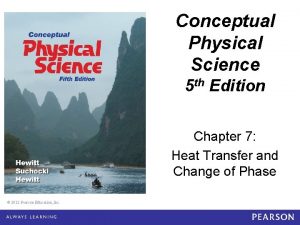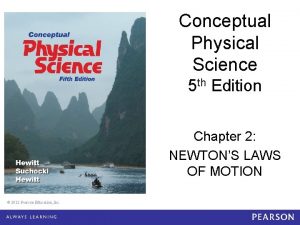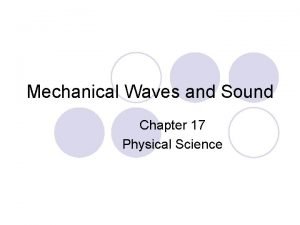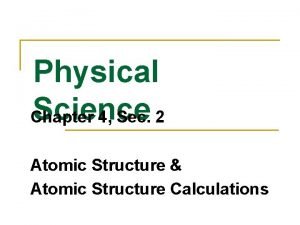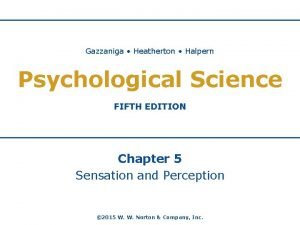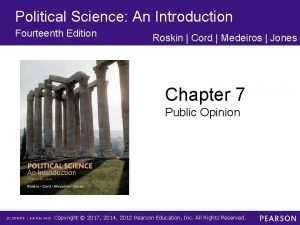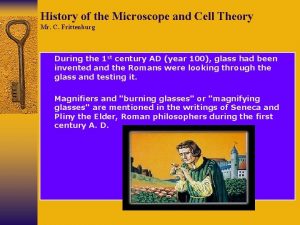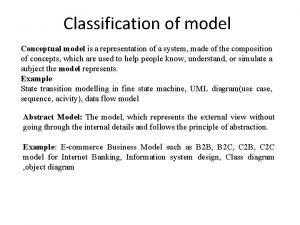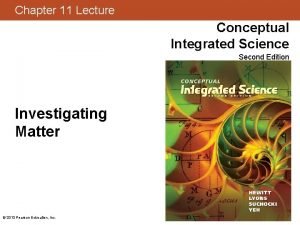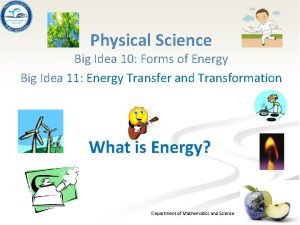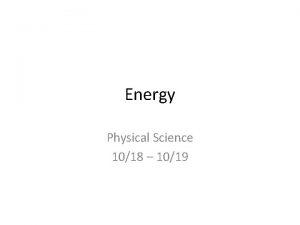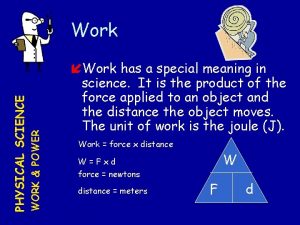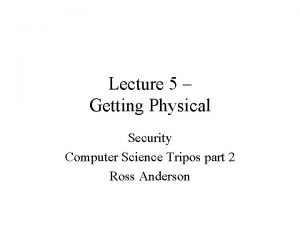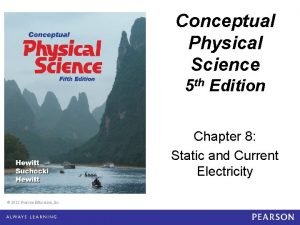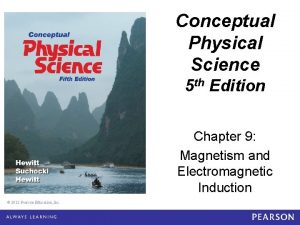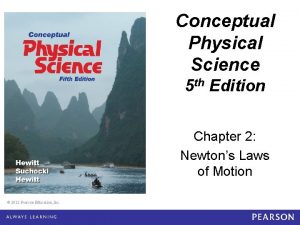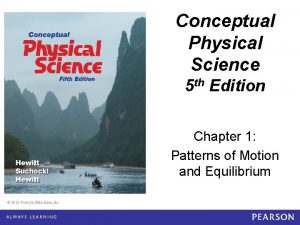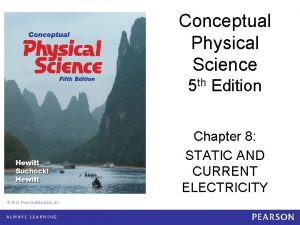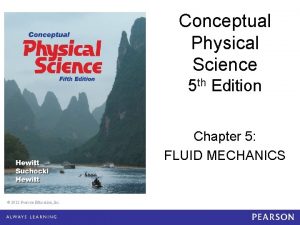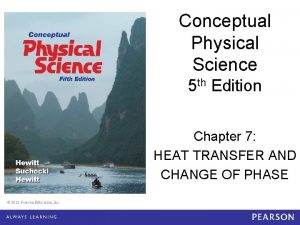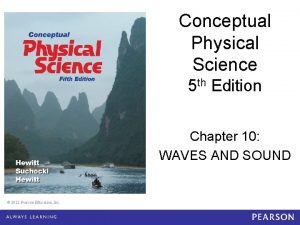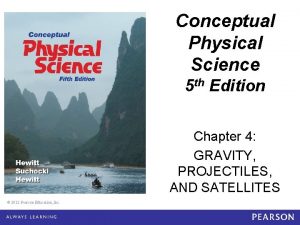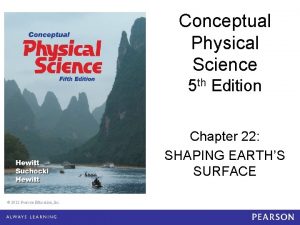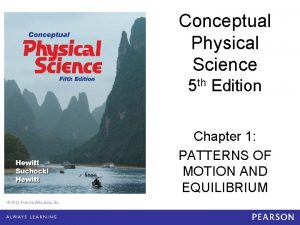Conceptual Physical Science 5 th Edition Chapter 11


























































- Slides: 58

Conceptual Physical Science 5 th Edition Chapter 11: LIGHT © 2012 Pearson Education, Inc.

This lecture will help you understand: • • Electromagnetic Spectrum Transparent and Opaque Materials Reflection Refraction Color Dispersion Polarization © 2012 Pearson Education, Inc.

Electromagnetic Nature of Light: • electromagnetic waves created by vibrating electric charges having frequencies that fall within the range of sight • frequency of vibrating electrons equals the frequency of the light • travels nearly a million times faster than sound in air • light and all electromagnetic waves are transverse waves © 2012 Pearson Education, Inc.

Electromagnetic Spectrum Electromagnetic wave • made up of vibrating electric and magnetic fields that regenerate each other by electromagnetic induction © 2012 Pearson Education, Inc.

Electromagnetic Spectrum The Electromagnetic Spectrum © 2012 Pearson Education, Inc.

Electromagnetic Spectrum CHECK YOUR NEIGHBOR The electromagnetic spectrum spans waves ranging from lowest to highest frequencies. The smallest portion of the electromagnetic spectrum is that of A. B. C. D. radio waves. microwaves. visible light. gamma rays. © 2012 Pearson Education, Inc.

Electromagnetic Spectrum CHECK YOUR ANSWER The electromagnetic spectrum spans waves ranging from lowest to highest frequencies. The smallest portion of the electromagnetic spectrum is that of A. B. C. D. radio waves. microwaves. visible light. gamma rays. Explanation: This can be inferred by a careful study of the spectrum and its regions in Figure 11. 3. © 2012 Pearson Education, Inc.

Electromagnetic Nature of Light Order of increasing frequency of visible light: • • • red violet—nearly twice the frequency of red ultraviolet—cause of sunburns X-rays gamma rays © 2012 Pearson Education, Inc.

Electromagnetic Nature of Light A situation to ponder… A photographer wishes to photograph a lightning bolt by setting a camera so that it is triggered by the sound of thunder. © 2012 Pearson Education, Inc.

A situation to ponder… CHECK YOUR NEIGHBOR Is this a good idea or a poor idea? A. B. C. D. Good idea for nearby lightning strikes. Good idea for all strikes. Poor idea for nearby lightning strikes. Poor idea for all strikes. © 2012 Pearson Education, Inc.

A situation to ponder… CHECK YOUR ANSWER Is this a good idea or a poor idea? A. B. C. D. Good idea for nearby lightning strikes. Good idea for all strikes. Poor idea for nearby lightning strikes. Poor idea for all strikes. Explanation: Light travels about a million times faster than sound. By the time the sound of thunder arrives, the lightning bolt is long gone. © 2012 Pearson Education, Inc.

Transparent and Opaque Materials Opaque materials: colored glass is opaque to much of incident white light © 2012 Pearson Education, Inc.

Transparent and Opaque Materials Light incident on: • dry surfaces bounces directly to your eye • wet surfaces bounces inside the transparent wet region, absorbing energy with each bounce, and reaches your eye darker than from a dry surface © 2012 Pearson Education, Inc.

Transparent and Opaque Materials Light is transmitted similar to sound • light incident on matter forces some electrons in matter to vibrate © 2012 Pearson Education, Inc.

Transparent and Opaque Materials How light penetrates a pane of glass • electrons in atoms of glass are forced into vibration • energy is momentarily absorbed and vibrates electrons in the glass • a vibrating electron either emits a photon or transfers the energy as heat • light slows due to time delay between absorption and reemission of photons © 2012 Pearson Education, Inc.

Transparent and Opaque Materials Average speed of light through different materials • • • vacuum—c (300, 000 m/s) atmosphere—slightly less than c (but rounded off to c) water— 0. 75 c glass— 0. 67 c, depending on material diamond— 0. 41 c © 2012 Pearson Education, Inc.

Transparent and Opaque Materials CHECK YOUR NEIGHBOR Strictly speaking, the photons of light incident on glass are A. B. C. D. also the ones that travel through and exit the other side. not the ones that travel through and exit the other side. absorbed and transformed to thermal energy. diffracted. © 2012 Pearson Education, Inc.

Transparent and Opaque Materials CHECK YOUR ANSWER Strictly speaking, the photons of light incident on glass are A. B. C. D. also the ones that travel through and exit the other side. not the ones that travel through and exit the other side. absorbed and transformed to thermal energy. diffracted. Explanation: Figure 11. 6 illustrates this nicely. A photon that exits the glass is not the same photon that began the process of absorption and reemission. © 2012 Pearson Education, Inc.

Reflection: the returning of a wave to the medium through which it came when encountering a reflective surface Law of reflection: angle of incidence = angle of reflection © 2012 Pearson Education, Inc.

Reflection Virtual image • same size as object, formed behind a mirror, and located at the position where the extended reflected rays converge • as far behind the mirror as the object is in front of the mirror © 2012 Pearson Education, Inc.

Reflection Plane mirror • note, the only axis reversed in an image is the front-back axis © 2012 Pearson Education, Inc.

Reflection Curved mirrors form a different virtual image • convex mirror (that curves outward): virtual image is smaller and closer to the mirror than the object • concave mirror (that curves inward): virtual image is larger and farther away than the object © 2012 Pearson Education, Inc.

Reflection Diffuse reflection • light striking a rough or irregular surface reflects in many directions • an undesirable circumstance is the ghost image that occurs on a non-cable TV set when TV signals bounce off buildings and other obstructions © 2012 Pearson Education, Inc.

Diffuse Reflection Application • The open-mesh parabolic dish is a diffuse reflector for short-wavelength light. • It is also a polished reflector for longwavelength radio waves. © 2012 Pearson Education, Inc.

Diffuse Reflection Different road surfaces determine amount of diffuse reflection • Rough road surface—diffuse reflection of illumination from your car headlights lets you see road ahead at night • Wet road surface is smooth—more plane mirror than diffuse, so seeing road ahead is more difficult Now you know! © 2012 Pearson Education, Inc.

Reflection CHECK YOUR NEIGHBOR When you stand 2 meters in front of a plane mirror, your image is A. B. C. D. 2 meters in back of the mirror. 4 meters from you. Both A and B. None of the above. © 2012 Pearson Education, Inc.

Reflection CHECK YOUR ANSWER When you stand 2 meters in front of a plane mirror, your image is A. B. C. D. 2 meters in back of the mirror. 4 meters from you. Both A and B. None of the above. © 2012 Pearson Education, Inc.

Refraction • bending of light when it passes from one medium to another • caused by change in speed of light © 2012 Pearson Education, Inc.

Refraction Here we see light rays pass from air into water and from water into air • pathways are reversible for both reflection and refraction © 2012 Pearson Education, Inc.

Refraction CHECK YOUR NEIGHBOR Refracted light that bends toward the normal is light that has A. B. C. D. slowed down. sped up. nearly been absorbed. diffracted. © 2012 Pearson Education, Inc.

Refraction CHECK YOUR ANSWER Refracted light that bends toward the normal is light that has A. B. C. D. slowed down. sped up. nearly been absorbed. diffracted. © 2012 Pearson Education, Inc.

Refraction CHECK YOUR NEIGHBOR Refracted light that bends away from the normal is light that has A. B. C. D. slowed down. sped up. nearly been absorbed. diffracted. © 2012 Pearson Education, Inc.

Refraction CHECK YOUR ANSWER Refracted light that bends away from the normal is light that has A. B. C. D. slowed down. sped up. nearly been absorbed. diffracted. Explanation: This question is a consistency check with the question that asks about light bending toward the normal when slowing. © 2012 Pearson Education, Inc.

Refraction Illusions caused by refraction • Objects submerged in water appear closer to the surface. © 2012 Pearson Education, Inc.

Refraction Illusions caused by refraction (continued) • Objects such as the Sun seen through air are displaced because of atmospheric refraction. © 2012 Pearson Education, Inc.

Refraction Illusions caused by refraction (continued) • Atmospheric refraction is the cause of mirages. © 2012 Pearson Education, Inc.

Refraction CHECK YOUR NEIGHBOR Which of these would not exist if light didn’t slow in transparent materials? A. B. C. D. Rainbows. Mirages. Magnifying glasses. All wouldn’t be. © 2012 Pearson Education, Inc.

Refraction CHECK YOUR ANSWER Which of these would not exist if light didn’t slow in transparent materials? A. B. C. D. Rainbows. Mirages. Magnifying glasses. All wouldn’t be. © 2012 Pearson Education, Inc.

Color we see depends on frequency of light ranging from lowest (red) to highest (violet). In between are colors of the rainbow. Hues in seven colors: red, orange, yellow, green, blue, indigo, and violet. Grouped together, they add to appear white. © 2012 Pearson Education, Inc.

Color Selective Reflection Most objects don’t emit light, but reflect light. A material may absorb some of the light and reflect the rest. Selective Transmission The color of a transparent object depends on the color of the light it transmits. © 2012 Pearson Education, Inc.

Color Mixed Color Lights Three types of cone receptors in our eyes perceive color— each stimulated by only certain frequencies of light: • lower-frequency light stimulate cones sensitive to low frequencies (red) • Middle-frequency light stimulate cones sensitive to mid-frequencies (green) • High-frequency light stimulate cones sensitive to high frequencies (blue) • Stimulation of all three cones equally, we see white light © 2012 Pearson Education, Inc.

Color Additive primary colors (red, blue, green): red + blue = magenta red + green = yellow blue + green = cyan © 2012 Pearson Education, Inc.

Color Opposites of primary colors: opposite of green is magenta opposite of red is cyan opposite of blue is yellow The addition of any color to its opposite color results in white. © 2012 Pearson Education, Inc.

Dispersion • process of separation of light into colors arranged by frequency • Components of white light are dispersed in a prism (and also in a diffraction grating) © 2012 Pearson Education, Inc.

Dispersion CHECK YOUR NEIGHBOR When white light passes through a prism, green light is bent more than A. B. C. D. blue light. violet light. red light. None of the above. © 2012 Pearson Education, Inc.

Dispersion CHECK YOUR ANSWER When white light passes through a prism, green light is bent more than A. B. C. D. blue light. violet light. red light. None of the above © 2012 Pearson Education, Inc.

Dispersion Rainbows • a colorful example of dispersion © 2012 Pearson Education, Inc.

Dispersion Rainbow detail © 2012 Pearson Education, Inc.

Dispersion Rainbow facts • an observer is in a position to see only a single color from any one droplet of water • your rainbow is slightly different from the rainbow seen by others • your rainbow moves with you • disk within the bow is brighter because of overlapping of multiple refractions (which don’t occur outside the disk) © 2012 Pearson Education, Inc.

Dispersion Rainbow facts (continued) • secondary rainbow is fainter (due to two internal reflections and refracted light loss). • secondary bow is reversed in color (due to the extra internal reflection) © 2012 Pearson Education, Inc.

Dispersion CHECK YOUR NEIGHBOR Compared with the primary rainbow, the secondary bow A. B. C. D. is dimmer. has colors reversed. is caused by two internal reflections. All of the above. © 2012 Pearson Education, Inc.

Dispersion CHECK YOUR ANSWER Compared with the primary rainbow, the secondary bow A. B. C. D. is dimmer. has colors reversed. is caused by two internal reflections. All of the above. © 2012 Pearson Education, Inc.

Polarization • alignment of transverse electric vectors in electromagnetic waves • property of transverse waves Left: E & M wave is polarized Right: rope vibrations are polarized • In both cases, wave is in the same plane as the plane of vibration. © 2012 Pearson Education, Inc.

Polarization Unpolarized light • vibrations producing light are in random directions © 2012 Pearson Education, Inc.

Polarization Polarized light • Unpolarized light divided into two internal beams polarized at right angles to each other. One beam is absorbed while the other beam is transmitted. © 2012 Pearson Education, Inc.

Polarization Polarized light (continued) • Use your knowledge of vectors and vector components to explain how light that can’t pass through a pair of Polaroids at right angles to each other will pass light when a third Polaroid is sandwiched between them! © 2012 Pearson Education, Inc.

Polarization CHECK YOUR NEIGHBOR Polarization occurs for waves that are A. B. C. D. transverse. longitudinal. Both A and B. Neither A nor B. © 2012 Pearson Education, Inc.

Polarization CHECK YOUR ANSWER Polarization occurs for waves that are A. B. C. D. transverse. longitudinal. Both A and B. Neither A nor B. © 2012 Pearson Education, Inc.
 Conceptual physical science 5th edition
Conceptual physical science 5th edition Microscopic slush in water tends
Microscopic slush in water tends Conceptual physical science 5th edition
Conceptual physical science 5th edition Conceptual physical science practice sheet chapter 2
Conceptual physical science practice sheet chapter 2 Branch of natural science
Branch of natural science Natural science vs physical science
Natural science vs physical science Eric’s favourite .......... is science
Eric’s favourite .......... is science Mis chapter 6
Mis chapter 6 Using mis 10th edition
Using mis 10th edition Physics chapter 2 review answers
Physics chapter 2 review answers Chapter 6 physical science
Chapter 6 physical science Chapter 14 review physical science
Chapter 14 review physical science Chapter 17 mechanical waves and sound
Chapter 17 mechanical waves and sound Physical science jeopardy
Physical science jeopardy Chapter 4 review physical science
Chapter 4 review physical science Chapter 11 physical science
Chapter 11 physical science Chapter 14 review physical science
Chapter 14 review physical science Physical science chapter 5 review
Physical science chapter 5 review Physical science chapter 6 review answers
Physical science chapter 6 review answers Chapter 16 review physical science
Chapter 16 review physical science Chemistry central science 14th edition
Chemistry central science 14th edition Biological science 6th edition
Biological science 6th edition Rotating snake illusion
Rotating snake illusion The fundamentals of political science research 2nd edition
The fundamentals of political science research 2nd edition Political science 14th edition
Political science 14th edition Political science 14th edition
Political science 14th edition Science power 9 atlantic edition
Science power 9 atlantic edition Conceptual physical and mathematical models are used to
Conceptual physical and mathematical models are used to Conceptual design vs physical design
Conceptual design vs physical design Conceptual integrated science explorations
Conceptual integrated science explorations Pearson physics
Pearson physics What is conceptual framework of science education
What is conceptual framework of science education Pricing strategies in marketing
Pricing strategies in marketing Physical fitness components and tests grade 9
Physical fitness components and tests grade 9 Sains pada kurikulum paud
Sains pada kurikulum paud Periodic table jeopardy
Periodic table jeopardy Noah carried a skateboard
Noah carried a skateboard Physical science eoc review
Physical science eoc review Physical science eoc review
Physical science eoc review Chapter 4 work and energy section 1 work and machines
Chapter 4 work and energy section 1 work and machines Big idea 8 properties of matter
Big idea 8 properties of matter Physical science lecture notes
Physical science lecture notes Pearson physical science concepts in action answers
Pearson physical science concepts in action answers Physical science force
Physical science force Academic standards in physical science
Academic standards in physical science What is displacement in physical science
What is displacement in physical science Big ideas 10 and 11 study guide forms of energy answers
Big ideas 10 and 11 study guide forms of energy answers Velocity physical science
Velocity physical science Exploring physical science
Exploring physical science Waves notes pdf download
Waves notes pdf download Lesson 1 thermal energy and the behavior of matter
Lesson 1 thermal energy and the behavior of matter K h d m d c m chart
K h d m d c m chart Characteristics of physical evidence
Characteristics of physical evidence Bacground
Bacground Physical science
Physical science Physical
Physical Physical science
Physical science Physical science 436
Physical science 436 Why johnny can't encrypt
Why johnny can't encrypt
